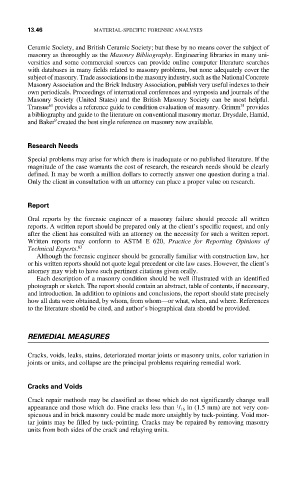Page 501 - Forensic Structural Engineering Handbook
P. 501
13.46 MATERIAL-SPECIFIC FORENSIC ANALYSES
Ceramic Society, and British Ceramic Society; but these by no means cover the subject of
masonry as thoroughly as the Masonry Bibliography. Engineering libraries in many uni-
versities and some commercial sources can provide online computer literature searches
with databases in many fields related to masonry problems, but none adequately cover the
subject of masonry. Trade associations in the masonry industry, such as the National Concrete
Masonry Association and the Brick Industry Association, publish very useful indexes to their
own periodicals. Proceedings of international conferences and symposia and journals of the
Masonry Society (United States) and the British Masonry Society can be most helpful.
31
61
Transue provides a reference guide to condition evaluation of masonry. Grimm provides
a bibliography and guide to the literature on conventional masonry mortar. Drysdale, Hamid,
9
and Baker created the best single reference on masonry now available.
Research Needs
Special problems may arise for which there is inadequate or no published literature. If the
magnitude of the case warrants the cost of research, the research needs should be clearly
defined. It may be worth a million dollars to correctly answer one question during a trial.
Only the client in consultation with an attorney can place a proper value on research.
Report
Oral reports by the forensic engineer of a masonry failure should precede all written
reports. A written report should be prepared only at the client’s specific request, and only
after the client has consulted with an attorney on the necessity for such a written report.
Written reports may conform to ASTM E 620, Practice for Reporting Opinions of
Technical Experts. 63
Although the forensic engineer should be generally familiar with construction law, her
or his written reports should not quote legal precedent or cite law cases. However, the client’s
attorney may wish to have such pertinent citations given orally.
Each description of a masonry condition should be well illustrated with an identified
photograph or sketch. The report should contain an abstract, table of contents, if necessary,
and introduction. In addition to opinions and conclusions, the report should state precisely
how all data were obtained, by whom, from whom—or what, when, and where. References
to the literature should be cited, and author’s biographical data should be provided.
REMEDIAL MEASURES
Cracks, voids, leaks, stains, deteriorated mortar joints or masonry units, color variation in
joints or units, and collapse are the principal problems requiring remedial work.
Cracks and Voids
Crack repair methods may be classified as those which do not significantly change wall
appearance and those which do. Fine cracks less than / 16 in (1.5 mm) are not very con-
1
spicuous and in brick masonry could be made more unsightly by tuck-pointing. Void mor-
tar joints may be filled by tuck-pointing. Cracks may be repaired by removing masonry
units from both sides of the crack and relaying units.

